Compositional Optimization of High-Performance Ferritic (HiperFer) Steels—Effect of Niobium and Tungsten Content
Abstract
1. Introduction
2. Methods and Materials
2.1. Alloy Design and Production
2.2. Microstructural Investigation
2.3. Mechanical Testing
3. Results and Discussion
3.1. Thermodynamic Modelling of Alloy Compositions
3.2. Precipitation Behaviour
3.3. Mechanical Properties
3.3.1. Hardness Evolution
3.3.2. Tensile Strength in the Solution Treated State (i.e., Solid Solution Hardening Effect)
3.3.3. Compression Creep
4. Conclusions
Author Contributions
Funding
Acknowledgments
Conflicts of Interest
References
- Toda, Y.; Tohyama, H.; Kushima, H.; Kimura, K.; Abe, F. Influence of Chemical Composition and Heat Treatment Condition on Impact Toughness of 15Cr Ferritic Creep Resistant Steel. JSME A 2005, 48, 125–131. [Google Scholar]
- Toda, Y.; Tohyama, H.; Kushima, H.; Kimura, K.; Abe, F. Improvement in creep strength of precipitation strengthened 15Cr ferritic steel by controlling carbon and nitrogen contents. JSME A 2005, 48, 35–40. [Google Scholar] [CrossRef]
- Toda, Y.; Seki, K.; Kimura, K.; Abe, F. Effects of W and Co on Long-term Creep Strength of Precipitation Strengthened 15Cr Ferritic Heat Resistant Steels. ISIJ Int. 2003, 43, 112–118. [Google Scholar] [CrossRef]
- Shibuya, M.; Toda, Y.; Sawada, K.; Kushima, H.; Kimura, K. Effect of nickel and cobalt addition on the precipitation-strength of 15Cr ferritic steels. Mater. Sci. Eng. A 2011, 528, 5387–5393. [Google Scholar] [CrossRef]
- Froitzheim, J.; Meier, G.H.; Niewolak, L.; Ennis, P.J.; Hattendorf, H.; Singheiser, L.; Quadakkers, W.J. Development of high strength ferritic steel for interconnect application in SOFCs. J. Power Sour. 2008, 178, 163–173. [Google Scholar]
- Kuhn, B.; Asensio Jimenez, C.; Niewolak, L.; Hüttel, T.; Beck, T.; Hattendorf, H.; Singheiser, L.; Quadakkers, W.J. Effect of Laves phase strengthening on the mechanical properties of high Cr ferritic steels for solid oxide fuel cell interconnect application. Mater. Sci. Eng. A 2011, 528, 5888–5899. [Google Scholar] [CrossRef]
- Hsiao, B.; Kuhn, Z.W.; Chen, D.; Singheiser, L.; Kuo, J.C.; Lin, D.Y. Characterization of Laves phase in Crofer 22 H stainless steel. Micron 2015, 74, 59–64. [Google Scholar] [CrossRef] [PubMed]
- Kuhn, B.; Talik, M.; Niewolak, L.; Zurek, J.; Hattendorf, H.; Ennis, P.J. Development of high chromium ferritic steels strengthened by intermetallic phases. Mater. Sci. Eng. A 2014, 594, 372–380. [Google Scholar] [CrossRef]
- Kuhn, B.; Talik, M.; Fisher, L.; Fan, X.; Yamamoto, Y.; Lopez Barrilao, J. Science and Technology of High Performance Ferritic (HiperFer) Stainless Steels. Metals 2020, 10, 463. [Google Scholar]
- Kuhn, B.; Talik, M.; Lopez Barrilao, J.; Singheiser, L. Microstructure Stability of Ferritic-Martensitic, Austenitic and Fully Ferritic Steels under Fluctuating Loading Conditions. In Proceedings of the 1st 123 HiMat Conference on Advanced High-Temperature Materials Technology for Sustainable and Reliable Power Engineering (123HiMAT-2015), Sapporo, Japan, 29 June–3 July 2015; pp. 94–97. [Google Scholar]
- Kuhn, B.; Fischer, T.; Yamamoto, Y.; Lopez Barrilao, J.; Fan, X. Mechanical Properties and Application Potentials of High Performance Ferritic (HiperFer) Steels. In Proceedings of the 4th International ECCC Creep & Fracture Conference, Duesseldorf, Germany, 10–14 September 2017. [Google Scholar]
- Kuhn, B.; Lopez Barrilao, J.; Fischer, T. “Reactive” Microstructure: The Key to Cost Effective, Fatigue Resistant High Temperature Structural Materials. In Proceedings of the EPRI’s 9th International Conference on Advances in Materials Technology for Fossil Power Plants and the 2nd International 123HiMAT Conference on High-Temperature Materials, Nagasaki, Japan, 21–25 October 2019; pp. 1–10. [Google Scholar]
- Lopez Barrilao, J.; Kuhn, B.; Wessel, E. Identification, size classification and evolution of Laves phase precipitates in high chromium, fully ferritic steels. Micron 2017, 101, 221–231. [Google Scholar] [CrossRef] [PubMed]
- Pöpperlová, J.; Fan, X.; Kuhn, B.; Bleck, W.; Krupp, U. Impact of tungsten on thermomechanically induced precipitation of laves phase in high performance ferritic (HiperFer) stainless steels. Appl. Sci. 2020, 10, 4472. [Google Scholar] [CrossRef]
- Lopez Barrilao, J.; Kuhn, B. Microstructure Evolution of Laves Phase Strengthened Ferritic Steels for High Temperature Applications. Ph.D. Thesis, RWTH Aachen University-FZ, Jülich, Germany, 2016. [Google Scholar]
- Lopez Barrilao, J.; Kuhn, B.; Wessel, E. Microstructure and intermetallic particle evolution in fully ferritic steels. In Proceedings of the 8th International Conference on Advances in Materials Technology for Fossil Power Plants, Albufeira, Portugal, 11–14 October 2016; pp. 1029–1037. [Google Scholar]
- Lopez Barrilao, J.; Kuhn, B.; Wessel, E. Microstructure evolution and dislocation behaviour in high chromium, fully ferritic steels strengthened by intermetallic Laves phases. Micron 2018, 108, 11–18. [Google Scholar] [CrossRef] [PubMed]
- Fan, X. Optimization of Laves Phase Strengthened High Performance Ferritic Stainless Steels. Ph.D. Thesis, RWTH Aachen University, Aachen, Germany, 5 May 2020. Available online: http://publications.rwth-aachen.de/record/792517/files/792517.pdf (accessed on 28 September 2020).
- Thelning, K.E. Steels and Its Heat Treatment; Butterworth & Co.: London, UK, 1984. [Google Scholar]
- Norton, F.H. The Creep of Steels at High Temperatures; Mc Graw-HilI: New York, NY, USA, 1929. [Google Scholar]
- Bailey, R.W. Creep of Steel under Simple and Compound Stresses, and the Use of High Initial Temperature in Steam Power Plants. In Proceedings of the Transactions of the World Power Conference, Tokyo, Japan, 29 October–7 November 1929; Volume 3, p. 1089. [Google Scholar]
- May, D.L.; Gordon, A.P.; Segletes, D.S. The application of the norton-bailey law for creep prediction through power law regression. In Proceedings of the ASME Turbo Expo 2013: Turbine Technical Conference and Exposition, GT2013-96008, San Antonio, TX, USA, 3–7 June 2013. [Google Scholar]
- Vo, N.Q.; Liebscher, C.H.; Rawlings, M.J.; Asta, M.; Dunand, D.C. Creep properties and microstructure of a precipitation-strengthened ferritic Fe–Al–Ni–Cr alloy. Acta Mater. 2014, 71, 89–99. [Google Scholar]
- Yang, M.; Zhu, J.; Yang, T.; Luan, J.; Jiao, Z.; Fan, X.; Kuhn, B.; Xiong, X.; Wang, C.; Liu, C.T.; et al. A novel ferritic steel family hardened by intermetallic compound G-phase. Mater. Sci. Eng. A 2019, 745, 390–399. [Google Scholar] [CrossRef]
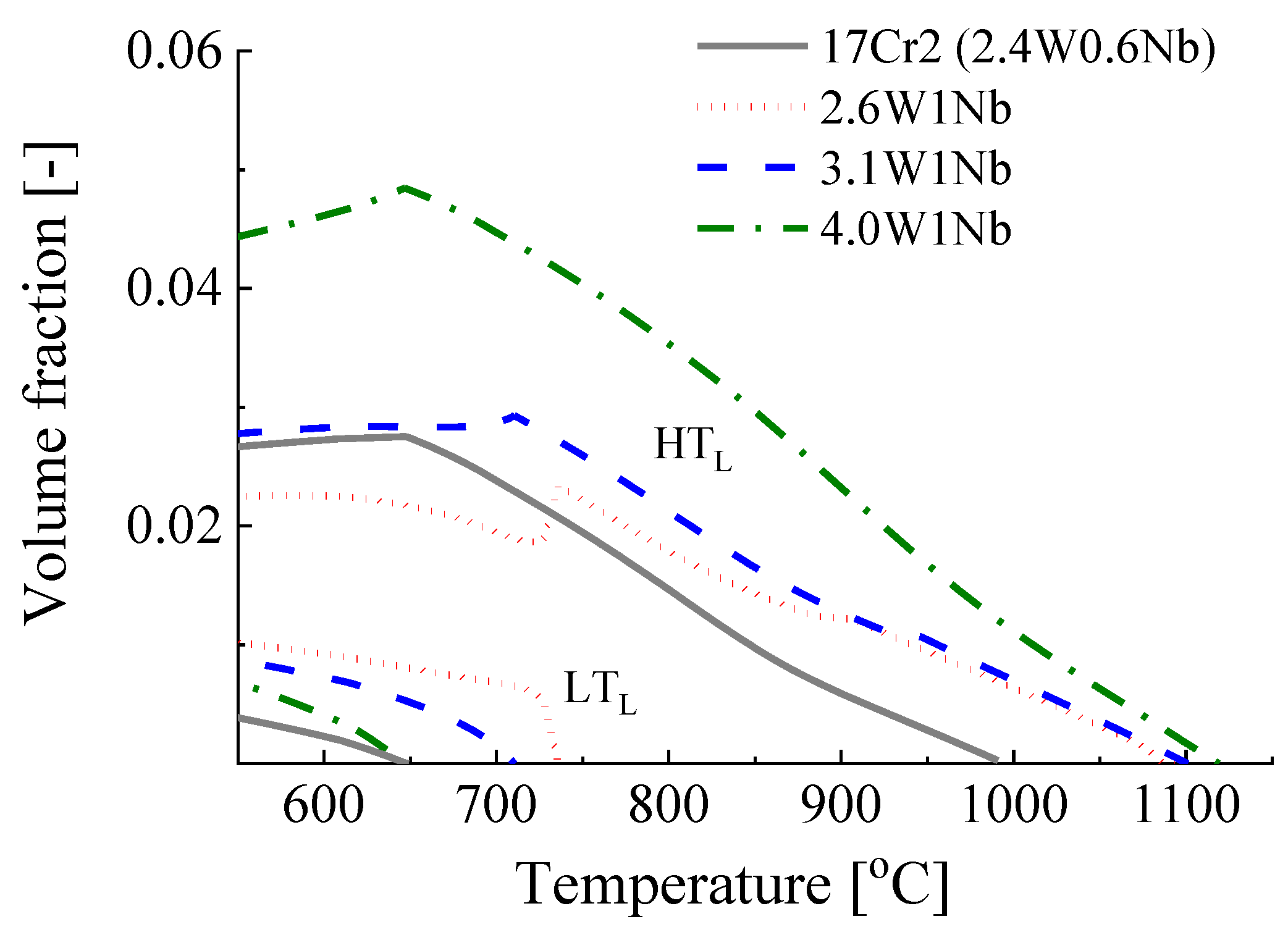
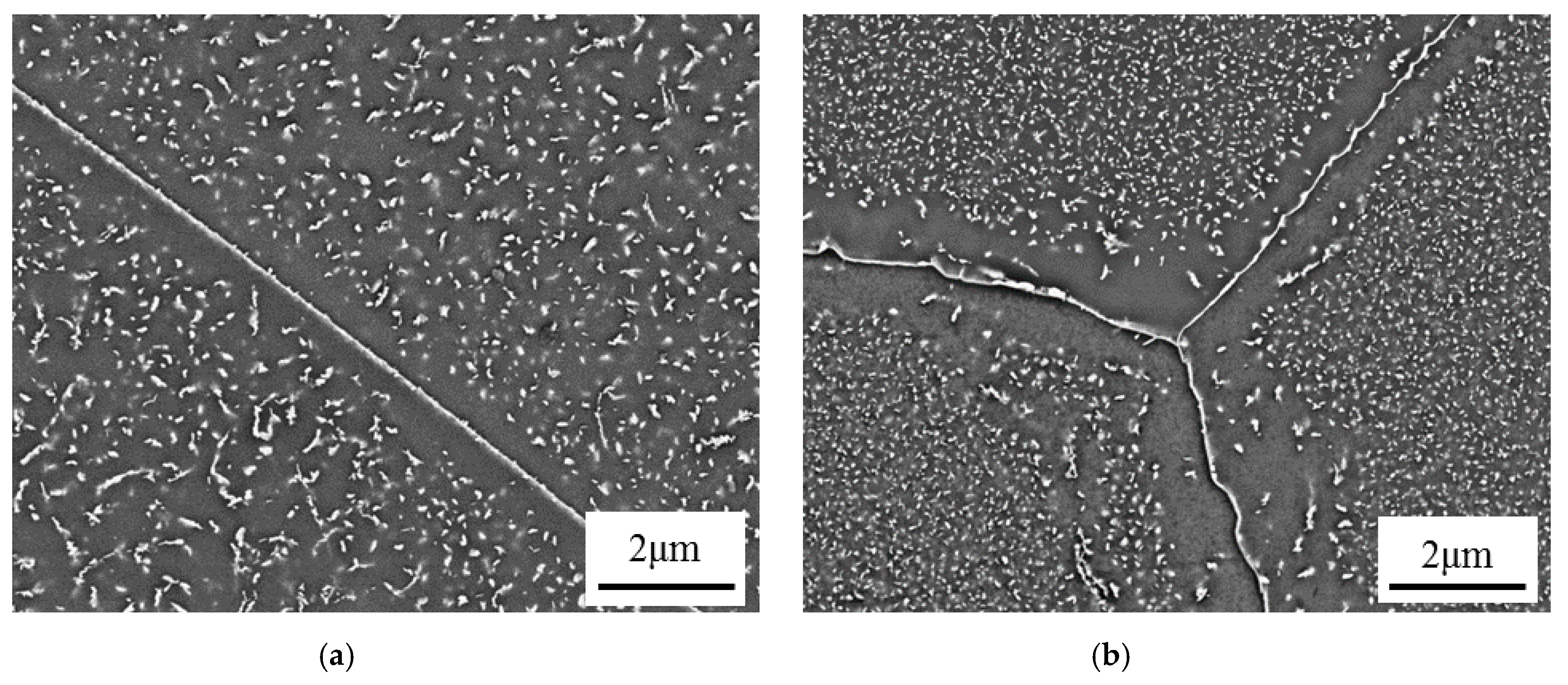

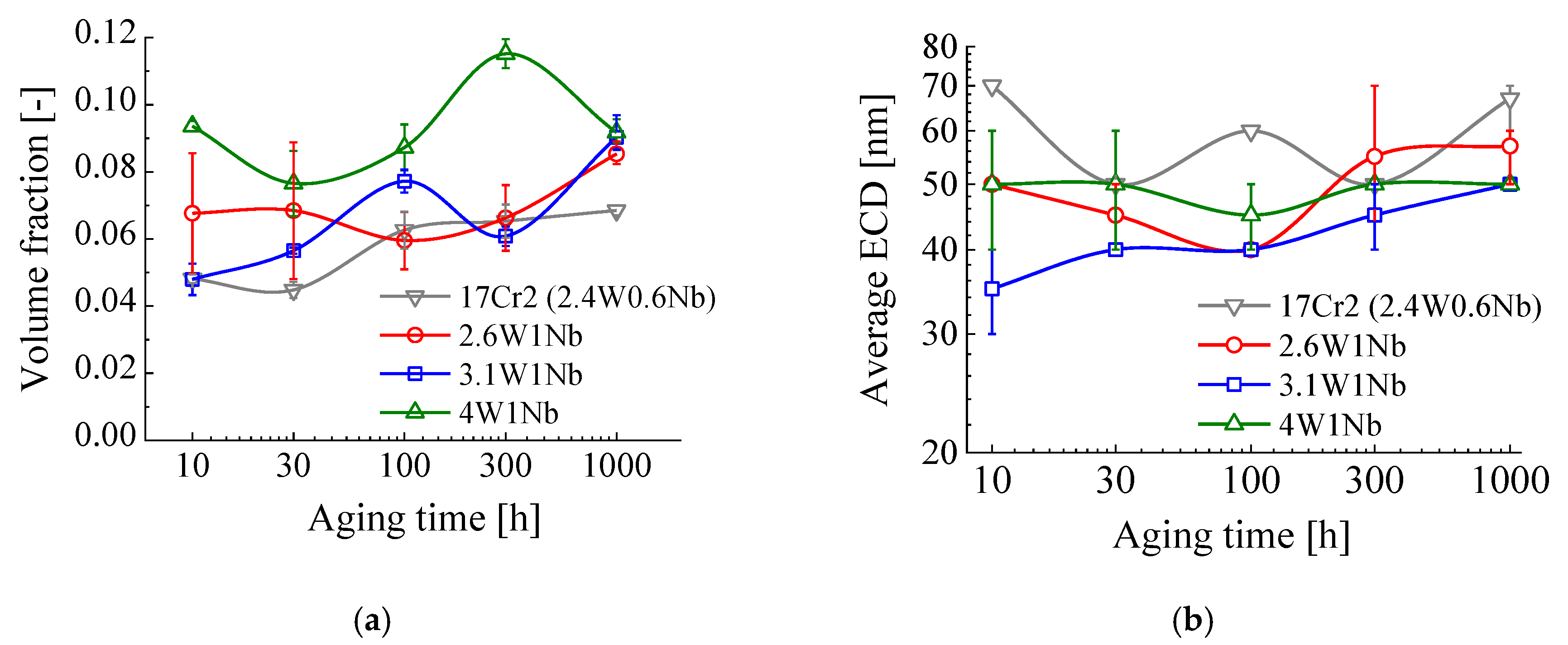
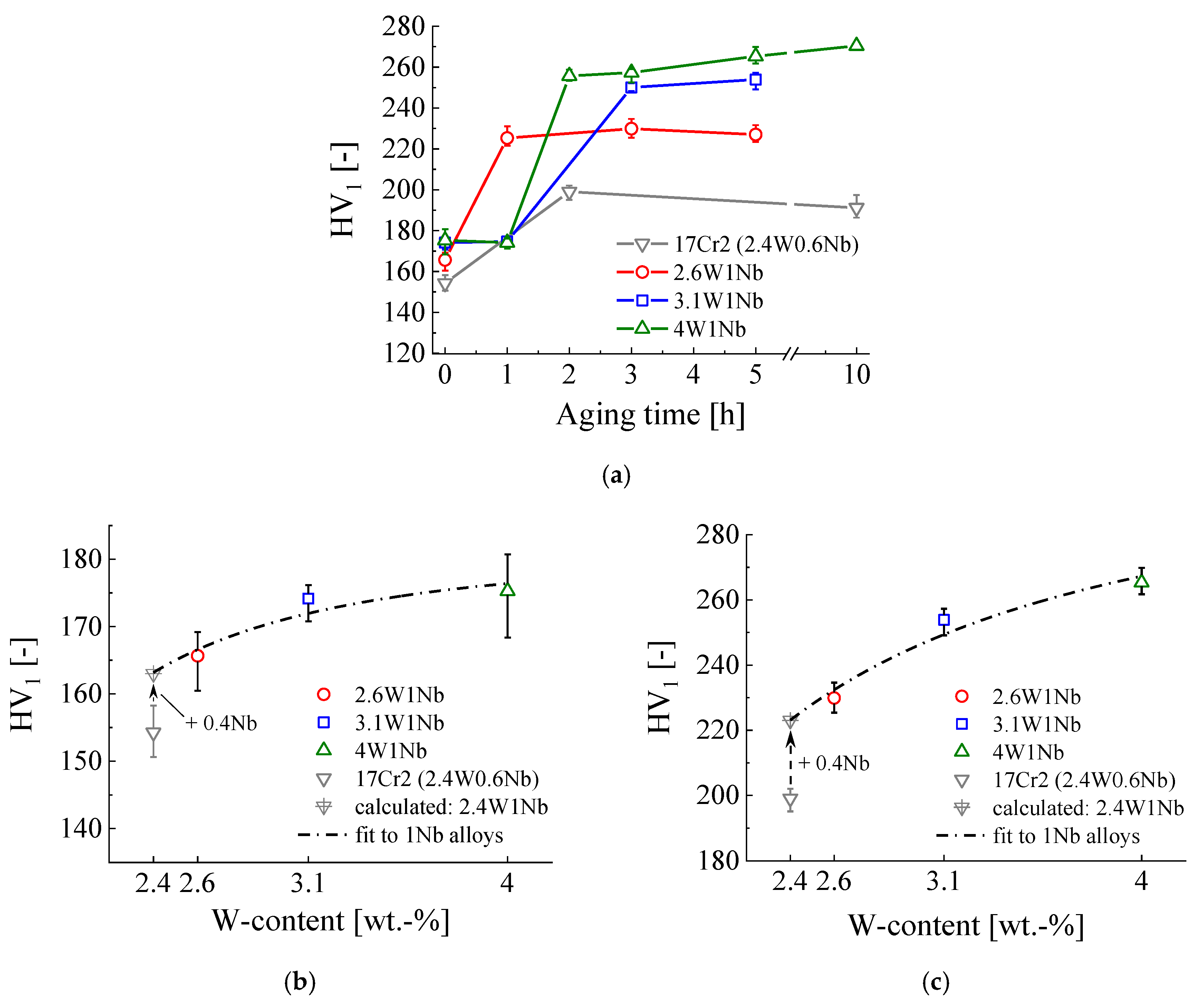
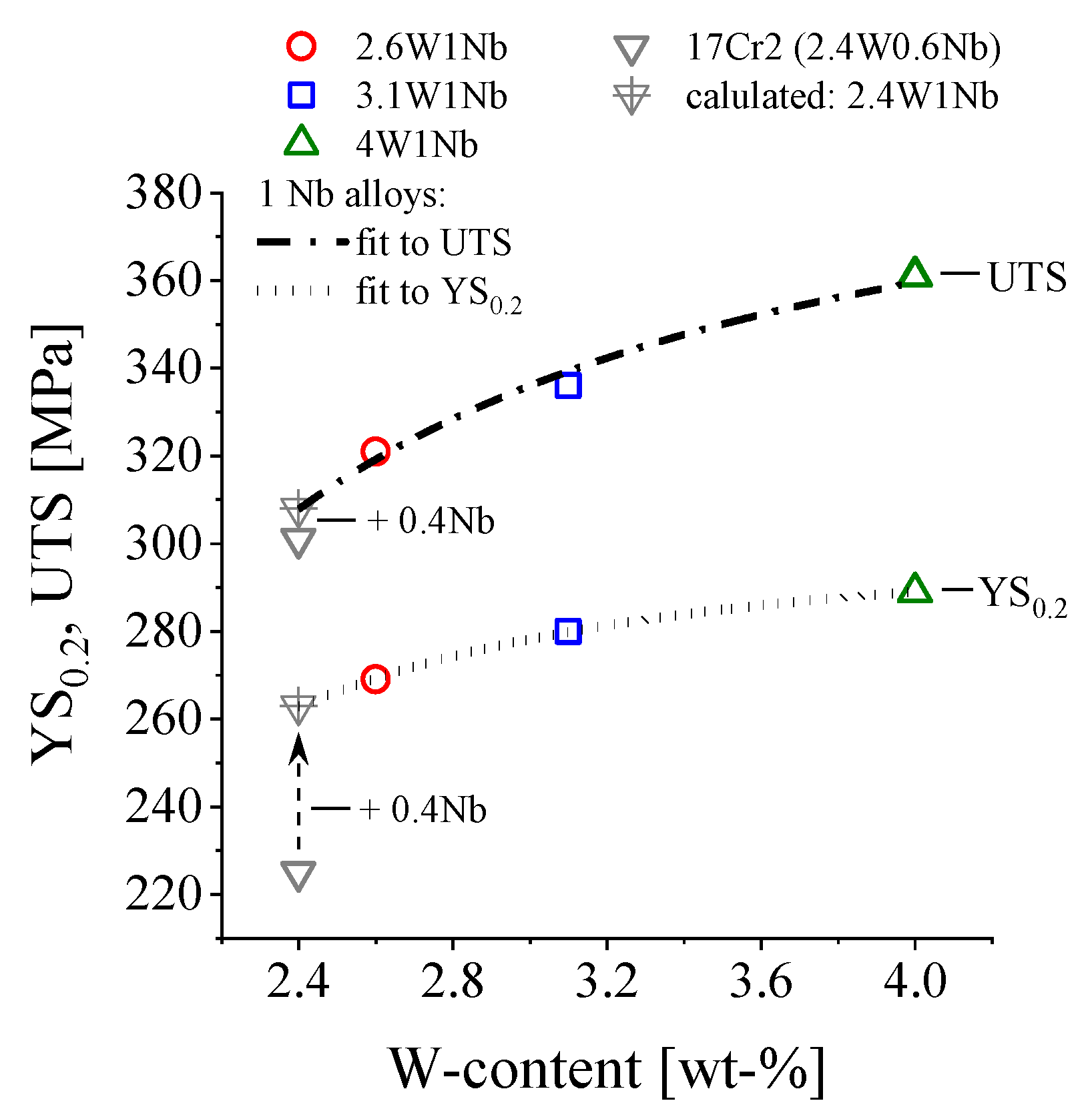
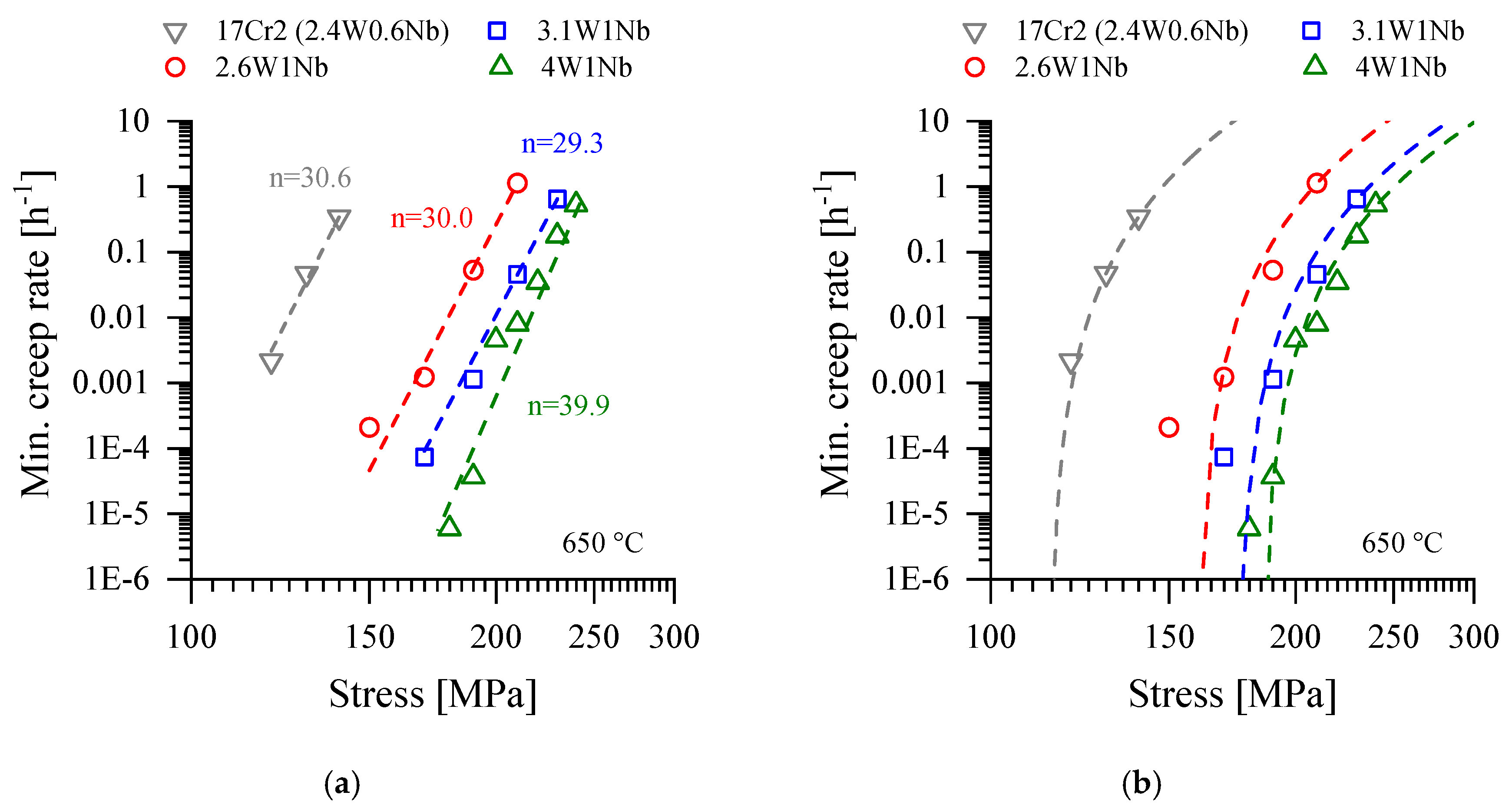

| Model Alloy | Cr | W | Nb | Si | Mn | Fe |
|---|---|---|---|---|---|---|
| 17Cr2 (2.4W0.6Nb) | 17.10 | 2.41 | 0.63 | 0.25 | 0.18 | R |
| 2.6W1Nb | 17.43 | 2.83 | 0.9 | 0.2 | 0.27 | R |
| 3.1W1Nb | 17.37 | 3.27 | 1.0 | 0.2 | 0.23 | R |
| 4W1Nb | 17.30 | 3.97 | 0.93 | 0.2 | 0.23 | R |
© 2020 by the authors. Licensee MDPI, Basel, Switzerland. This article is an open access article distributed under the terms and conditions of the Creative Commons Attribution (CC BY) license (http://creativecommons.org/licenses/by/4.0/).
Share and Cite
Fan, X.; Kuhn, B.; Pöpperlová, J.; Bleck, W.; Krupp, U. Compositional Optimization of High-Performance Ferritic (HiperFer) Steels—Effect of Niobium and Tungsten Content. Metals 2020, 10, 1300. https://doi.org/10.3390/met10101300
Fan X, Kuhn B, Pöpperlová J, Bleck W, Krupp U. Compositional Optimization of High-Performance Ferritic (HiperFer) Steels—Effect of Niobium and Tungsten Content. Metals. 2020; 10(10):1300. https://doi.org/10.3390/met10101300
Chicago/Turabian StyleFan, Xiuru, Bernd Kuhn, Jana Pöpperlová, Wolfgang Bleck, and Ulrich Krupp. 2020. "Compositional Optimization of High-Performance Ferritic (HiperFer) Steels—Effect of Niobium and Tungsten Content" Metals 10, no. 10: 1300. https://doi.org/10.3390/met10101300
APA StyleFan, X., Kuhn, B., Pöpperlová, J., Bleck, W., & Krupp, U. (2020). Compositional Optimization of High-Performance Ferritic (HiperFer) Steels—Effect of Niobium and Tungsten Content. Metals, 10(10), 1300. https://doi.org/10.3390/met10101300






